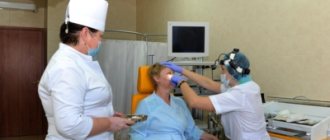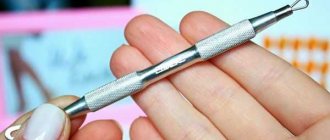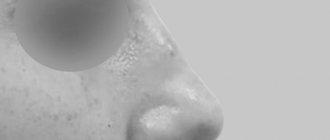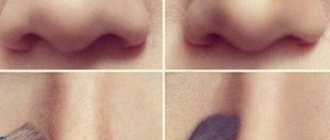Laser coagulation of nasal vessels is a surgical intervention involving cauterization of vessels located on the nasal septum using laser radiation. Our clinic has everything necessary for successful laser vasotomy in Krasnodar. During the procedure, in order to evaporate pathological cells, the specialist directs the rays precisely to the affected area. According to our statistics, the operation helps to heal and restore the normal functioning of the mucous membrane of the nasal passages in 98% of cases of the total number of interventions performed.
Principles of laser treatment of telangiectasia
Laser therapy is a fairly “young” direction in aesthetic medicine, which began to actively develop and be used for the treatment of skin diseases only in 1970. Despite this, laser treatment has already established itself as one of the most effective methods of combating age-related and stress-related changes, external defects (scars, scars, stretch marks, rosacea, age spots), as well as chronic inflammatory skin diseases.
In dermatology, laser therapy is also used to treat chronic infectious skin diseases (acne, acne, furunculosis) without exacerbation, since the laser flow has a powerful antibacterial effect and provides disinfection in the deep layers of the dermis. Laser light radiation is especially active against coccal flora, representatives of which are the main causative agents of skin infections.
Laser therapy helps get rid of many skin diseases
The use of laser in the treatment of vascular pathologies became possible thanks to the development of a fractional laser thermolysis technique based on fragmentary effects on the tissues of the epidermis and dermis, as well as their components (blood vessels, lymphatic ducts, hair follicles, sebaceous glands, etc.). The beam penetrates the tissues to a given depth, warms them up, as a result of which the excess blood filling the dilated vessels is “evaporated” and the walls of the capillaries stick together.
The therapeutic effect of laser therapy in the treatment of rosacea is due to the following processes occurring in the damaged vessel under the influence of laser light energy:
- absorption of laser radiation by the blood, as a result of which it heats up to 280-300, and steam bubbles form in it;
- thermal damage to the vascular wall (as a result of contact with hot steam bubbles), which causes destruction of the endothelial layer lining the vessels from the inside;
- thickening of proteins in the subendothelial lining of the vessel;
- increased activity of endothelial cells responsible for endothelial regeneration and restoration of normal blood flow;
- the formation of necrotic changes in the vascular wall.
Effect of laser on blood vessels
The meaning of the procedure is to “glue” the vessel and evaporate excess accumulated blood. The result of laser thermolysis ranges from a reduction in size and color intensity to the complete removal of blood vessels on the face.
Who is indicated for laser coagulation of blood vessels?
Laser coagulation of blood vessels (not to be confused with endovasal laser coagulation of veins, which is a medical procedure and is performed strictly in a hospital setting) can be used to treat all manifestations of rosacea, as well as scars and scars remaining on the skin after removal of moles and other neoplasms.
The use of laser on the face is effective in the presence of the following cosmetic skin defects:
- vascular points and asterisks;
- vascular networks consisting of clearly visible small blood vessels (venules, arterioles, capillaries) of red or burgundy color;
- benign tumors formed from endothelial cells lining the surface of blood vessels from the inside (hemangiomas);
- capillary moles (flaming nevi);
- tumors consisting of newly formed blood vessels (angiomas);
- symptoms of rosacea (papules, red spots, telangiectasia, pustules).
Rosacea is one of the indications for laser therapy
The number of procedures required to completely remove blood vessels on the face is selected individually and depends on the number of defects and the time of their appearance. For example, to get rid of fresh hemangiomas, 1 procedure is usually sufficient. For vascular defects, from the moment of appearance of which 1 to 3 years have passed, you will need to undergo 3-4 procedures. The same number of sessions is necessary when working with a large number of dilated vessels (vascular networks).
Note! If necessary, removal of blood vessels on the face can be carried out simultaneously with other cosmetic procedures, for example, laser rejuvenation or fractional resurfacing of scars and scars.
Who needs to have the procedure?
The main indications for laser coagulation of nasal vessels are pathological conditions of the capillaries of the nasal passages, which are accompanied by frequent bleeding:
- chronic inflammatory processes of the nasal passages with thinning of the mucous membrane, sinuses, nasopharynx (chronic rhinitis, sinusitis);
- congenital and acquired curvature of the nasal septum;
- individual features of the structure of the capillary network in the nose;
- regular exposure to adverse environmental factors, as well as inhalation of dust and toxic substances at work;
- hypertonic disease;
- hormonal imbalance, chronic fatigue, stressful situations;
- hypovitaminosis conditions;
- long-term use of blood thinning medications.
A serious reason for surgery is frequent relapses of bleeding from the nasal cavity, which as a result can provoke the development of anemia, persistent arterial hypotension and even a state of shock.
Advantages and disadvantages
An important advantage of fractional laser therapy over surgical methods of vessel removal (including minimally invasive endovasal laser obliteration) is the absence of a difficult rehabilitation period. The patient can do his usual activities and return to work duties the very next day after the procedure, while pain after using the laser is practically absent thanks to the use of modern radial light guides.
Radial light guides are used for laser removal of blood vessels.
Among the positive characteristics of laser coagulation, the following are also particularly significant:
- comfort for the patient (no severe pain during laser operation and during the recovery period);
- low likelihood of side effects and complications if you follow the technique of using the device, proper preparation and compliance with the cosmetologist’s recommendations after the procedure;
- Possibility of use in patients with any skin type;
- short duration of exposure (about 15-20 minutes);
- lack of invasive intervention, reducing the risk of infection;
- high performance.
During one procedure, the doctor has the opportunity to treat several areas or large areas at once, and in most cases the procedure does not require the use of general anesthesia, which is necessary when using surgical techniques.
The procedure causes minimal discomfort
Important! One of the undeniable advantages of laser coagulation using non-ablative fractional lasers is the absence of trauma to surrounding tissues (the light flux acts only on the vessel wall), as well as deep renewal and restoration of the skin due to the activation of regenerative processes.
Disadvantages of the method
In addition to a large number of advantages, removing blood vessels using a laser also has disadvantages, including:
- high probability of relapse. To prevent blood vessels from appearing on the face again, it is important to undergo a comprehensive examination and find out the cause of their occurrence. If all provoking factors are not eliminated, the risk of re-exacerbation of rosacea will be quite high;
- short term effect. If the patient takes hormonal medications, suffers from endocrine pathologies, liver diseases, systemic connective tissue lesions, the effect of laser coagulation will last for several months, after which the vessels may appear again (but the already treated capillaries will still be much lighter);
- the need to undergo a course of treatment. In most cases, 1 procedure is not enough to completely remove spider veins and spider veins, so the patient will have to visit the cosmetologist’s office several times.
In case of significant vascular damage, several courses of laser therapy will be required.
The disadvantages of the method include the rather high cost of the course, which can reach up to 30-45 thousand rubles.
Preparing for surgery
Despite the low-impact nature of laser coagulation, doctors at our clinic approach its preparation with the utmost seriousness. First, the patient is scheduled for a consultative visit to a specialist, where he determines the indications for correction, explains to the patient the essence of the future intervention and warns about the likely consequences.
Before surgery, each patient at the clinic must pass the prescribed tests and, if necessary, undergo a diagnostic examination. After all this, the specialist conducts a second consultation and sets a date and time for the procedure.
In the process of preparing for surgery, the patient is prohibited from:
- drink alcohol;
- take medications to thin your blood.
It is very important to listen to all doctor's recommendations. Otherwise, the risk of complications increases several times.
How is the procedure done?
The procedure for laser removal of blood vessels on the face or other parts of the body is carried out in a cosmetology office and takes about 20 minutes. The patient is placed on a medical couch, after which a procedure is carried out to cleanse the face of dust, dirt, dead skin cells and excess sebum. For pain relief, a local anesthetic (Akriol Pro, Emla) in the form of a gel is applied to the skin. These drugs contain a combination of two anesthetics - lidocaine and prilocaine - and are used to provide skin anesthesia. The effect of the gel begins after 30-40 minutes.
Anesthetic cream "Akriol Pro"
Laser treatment is a zonal direction of the light flux to areas in which dilated vessels are located. The doctor brings the device to the skin and directs the diodes to the area where the vascular defects are located. The operation of the device is similar to flashes, during which the patient may feel dull clicks. The number of outbreaks depends on the location of the vessel, its size and the degree of filling with blood, which can be judged by color.
After the procedure, the doctor applies a soothing cream with panthenol to the face and gives detailed recommendations on skin care during the recovery period.
Important! The procedure for laser treatment of blood vessels is carried out strictly in protective glasses. These glasses are necessary to protect your eyes from burns. During laser flashes, the patient may experience involuntary lacrimation, which may also persist for 1-2 hours after the procedure. If this symptom does not go away after this time, you should consult an ophthalmologist to rule out a thermal burn of the retina or cornea.
A prerequisite is the presence of safety glasses
Progress of the operation
Our clinic employs the best specialists in the city of Krasnodar. Before surgery, the patient's blood pressure is measured again and the procedure is explained. The manipulation is performed in the operating room under local anesthesia. Patients with a vulnerable psyche are given sedatives.
During the operation:
- the patient takes a comfortable vertical body position with the head end raised;
- breathing should be done through the mouth, which will prevent vapors from entering the lungs;
- if necessary, during laser vasotomy manipulation, a smoke evacuation device operates;
- laser cauterization occurs inside the nasal concha without damaging the integrity of the mucous membranes and cilia;
- if necessary, the operation is performed under the control of endoscopic equipment, which also allows one to evaluate the results of the correction performed.
Laser coagulation of blood vessels in the area of the nasal septum is an absolutely painless procedure. Our surgeons always warn patients that during the procedure they may feel some discomfort or a slight tingling in the nose. Such manifestations are normal and do not pose a threat to human health.
After the procedure: recommendations from cosmetologists
The recovery period after laser removal of blood vessels on the face lasts on average 8-10 days. During this time, red spots (traces from the laser) may remain on the skin. The healing process of the skin is accompanied by the formation of yellow crusts that cannot be peeled off on your own. There is usually no pain during the recovery period. Only 15-20% of patients complain of severe burning and tingling at the treatment site, which subside after contact with cold air. If the discomfort is too severe, non-steroidal painkillers based on ibuprofen, ketorolac or diclofenac can be taken.
The crusts must be treated with chlorhexidine or any other antiseptic in the form of an aqueous solution 2 times a day (moisten a cotton pad generously and apply it to the healing area for 5-7 minutes). For 3-5 days, you need to apply Bepanten or Panthenol cream to your face: products based on panthenol accelerate healing, stimulate the regeneration of epidermal cells, and soothe the skin after aggressive laser exposure.
Before healing, the skin should be treated with chlorhexidine solution
To prevent side effects and complications throughout the entire recovery period, it is prohibited:
- swim in open water (this can lead to infection of the wound surface);
- take a steam bath or sauna;
- visit the solarium;
- in the summer season - stay outside during periods of maximum solar activity (from 12 to 17 hours);
- use cosmetics that can additionally injure the skin (products with ground bones, salt, scrubs, peelings, rays);
- engage in strength and dynamic sports;
- be in an inclined position for a long time.
Water for washing should be at room temperature
For two weeks after the procedure, you must apply a protective cream with SPF 30+ to your face.
Stages of laser removal
Laser treatment consists of a direct effect on hemoglobin, the concentration of which increases with vasodilation. The areas of skin that are nearby remain untouched. Blood cells are heated by laser waves that have a certain length. As a result, the walls of the damaged vessel begin to stick together. After a few weeks, traces of it disappear.
Laser removal of blood vessels on the face is carried out in stages:
- The specialist treats the skin with an anesthetic.
- The patient and the doctor must wear special glasses that protect their eyes from bright flashes during the procedure.
- To avoid burns, cooling sprays or saprophytic glasses are used.
- Damaged capillaries begin to be heated by the laser. During the procedure, it is important to monitor the color of the treated area. If a purple tint appears, then the work can be completed.
Contraindications and side effects
The likelihood of side effects after the procedure is quite low if the treatment technology (laser type, wavelength, frequency, needle diameter, operating mode, etc.) was followed during the session, and after the manipulation the patient complied with all the specialist’s instructions. The most common side effect of the laser is redness. The skin at the site of exposure looks burnt, red spots appear on it, which may be accompanied by a burning and tingling sensation. The maximum intensity of these symptoms is observed in the first three days after laser coagulation, after which the redness begins to gradually subside and the pain completely disappears.
Other side effects that may be considered as possible complications of this procedure include: hyperpigmentation, scarring, skin thickening, and skin infection. To prevent infections after the procedure, the patient may be prescribed bactericidal drugs, for example, metronidazole.
Bactericidal gel "Metrogil"
Contraindications
Contraindications for laser removal of facial vessels are:
- age under 18 years;
- malignant tumors of any location;
- purulent-inflammatory pathologies of the skin at the location of the defect, as well as any infectious diseases in the acute stage;
- tumors and other neoplasms of unspecified etiology in the immediate vicinity of the dilated vessel;
- severe mental disorders (schizophrenia, epilepsy);
- pregnancy and lactation;
- bleeding disorders and severe disorders of the hematopoietic system;
- keloid scars;
- diabetes mellitus type 1 and 2 in the stage of decompensation.
Laser therapy is contraindicated for breastfeeding women
Laser thermolysis is strictly contraindicated if you have a fresh tan. If the patient has recently visited a solarium or sunbathed in the open sun, the procedure can be prescribed no earlier than 3-4 weeks later.
The main advantages of laser coagulation
Laser coagulation is one of the minimally invasive techniques that have a number of advantages over conventional surgical interventions involving soft tissue incisions:
- after the operation there is no need for nasal tamponade;
- with laser vasotomy, the risk of bleeding from the vessels in the nose is eliminated;
- During the procedure, the vessels are sealed, so their rupture is impossible;
- the operation lasts 15-45 minutes;
- very small wounds remain on the surface of the mucous membranes of the nose after the procedure;
- nasal breathing is completely restored within three days after the procedure.
A huge advantage of laser coagulation is a short rehabilitation period. On average, it lasts no more than seven days. After the operation, patients are under the supervision of our specialists for about half an hour and then sent home.
Why do blood vessels reappear after laser therapy?
Laser therapy is considered a less effective method than sclerotherapy or radiofrequency ablation. If the problem reappears after a few months, it is necessary to contact an angiosurgeon and find out the cause of its occurrence, since until all provoking factors are eliminated, relapses can occur periodically.
Possible causes of the formation of vascular defects on the face include:
- connective tissue diseases (systemic lupus erythematosus, scleroderma, etc.);
- chronic vein pathologies (venous insufficiency, varicose veins);
- liver diseases (fatty degeneration, cirrhosis, hepatitis);
- endocrine disorders.
In some cases, the reasons for the reappearance of telangiectasias are external factors not related to the work of internal factors: sudden changes in temperature, intense physical activity, consumption of drinks containing caffeine and ethyl alcohol (in large quantities). In women, relapse of rosacea can be triggered by hormonal imbalances and pregnancy.
Important! If the patient is taking hormonal medications (including topical corticosteroids), the likelihood of recurrence of telangiectasias will be very high, so in cases where hormonal therapy cannot be discontinued, laser treatment is an ineffective way to combat vascular defects.
Indications and contraindications
This method is very effective and has many advantages:
- non-traumatic method;
- painless intervention that does not require special preparation;
- the risk of complications is minimal;
- easy, short postoperative period without pain and swelling;
- performed on an outpatient basis.
Cauterization of blood vessels is not performed during exacerbation of chronic ENT diseases, inflammatory processes of the paranasal sinuses (paranasal sinuses), as well as for pregnant women and cancer patients. Among the contraindications, the following diagnoses and conditions should also be noted: bleeding disorders, strokes, heart attacks, kidney diseases, epilepsy.
The recovery period is quick and easy if you follow simple recommendations:
- you need to stop visiting saunas and baths;
- you cannot swim in pools and ponds;
- avoid physical activity and visits to the gym;
- You should avoid alcoholic beverages and coffee.
| Medical service | price, rub. |
| Radio wave coagulation of a bleeding vessel of the nasal septum (one side) | 5000 |
Cost of the procedure
The cost depends on the location of the defect and its area. Approximate prices for laser removal of blood vessels are shown in the table below.
Cost of laser treatment for telangiectasia on the face
| Processing area | Cost of 1 session |
| Wings of the nose | 2000 rubles |
| Cheeks | 3000 rubles |
| Full face and neck | 7500 rubles |
| Full face | 6200 rubles |
| Face, neck and décolleté | 8600 rubles |
Photos before and after
Photos before and after removal of blood vessels with laser No. 1
Photos before and after removal of blood vessels with laser No. 2
Photos before and after removal of blood vessels with laser No. 3
Removing dilated vessels on the face using a laser is a fairly effective, comfortable and safe way to correct the external manifestations of rosacea. In most cases, the problem can be dealt with in 1-3 procedures. Laser therapy is a more gentle way to get rid of telangiectasia compared to surgical methods, therefore it is increasingly used in aesthetic medicine and hardware cosmetology. If the patient is healthy and adheres to a normal lifestyle and routine, spider veins after laser treatment do not return for a long time.











